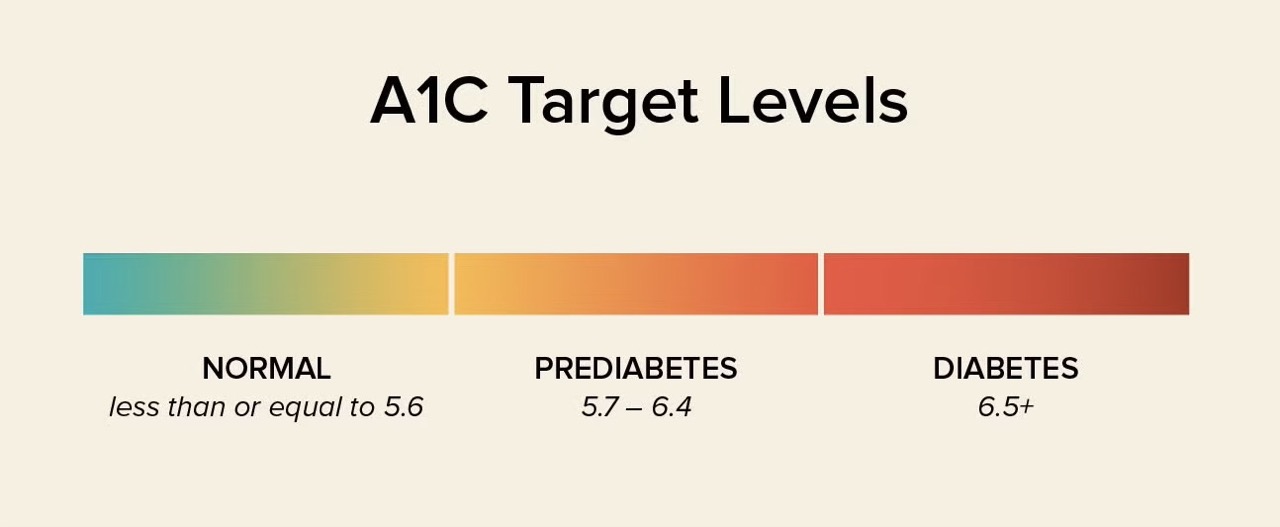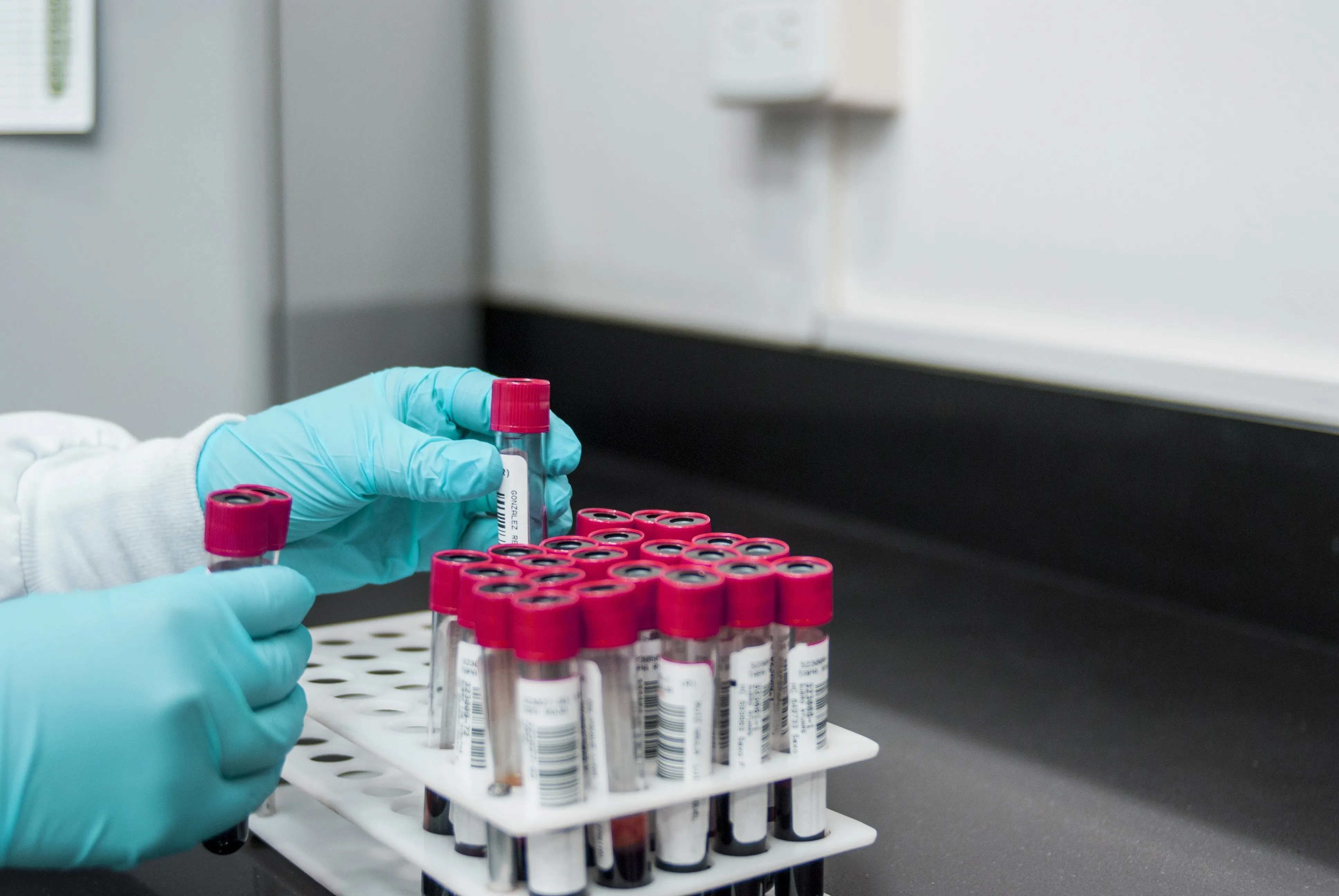Diabetes, Pre-Diabetes & Insulin Resistance: The Science of Restoring Metabolic Health Through Lifestyle and Nutrition
Get Personalized Insights

Diabetes, Pre-Diabetes & Insulin Resistance
Type 2 diabetes and pre-diabetes arise from insulin resistance.
Diabetes and insulin resistance affect the majority of the population and are among the leading causes of disease worldwide.
They are driven by lifestyle, diet, and nutrient deficiencies in the body. Medical interventions targeting lifestyle, correction of deficiencies, and nutrition can radically alter the health trajectory of patients with diabetes, pre-diabetes, and insulin resistance.
Insulin is a hormone produced by the pancreas that enables glucose in the blood to enter cells, where it is used for energy. Glucose comes from the food we eat. The liver also produces glucose when needed, such as during fasting.
Each time we eat, blood glucose levels rise. The body then secretes insulin to lower glucose levels and maintain them within normal limits.
Insulin Resistance
Insulin resistance is a condition in which cells, attempting to protect themselves from excess glucose, reduce their responsiveness to insulin. As a result, the pancreas produces more insulin to help glucose enter cells.
As long as the pancreas can produce enough insulin to overcome this reduced cellular sensitivity, blood glucose levels remain within normal limits. In a person who responds normally to insulin, 3 to 5 mIU/mL of insulin in the blood is sufficient to maintain normal glucose levels.
In a person with insulin resistance, up to ten times more insulin — 30 mIU/mL or higher — may be required to maintain glucose within the normal range. This stage is known as pre-diabetes. The pre-diabetic stage usually lasts several years and is the period during which significant bodily damage occurs due to chronically elevated insulin secretion.
Gradually, over time, the excessive insulin demand overwhelms the pancreas, which can no longer meet the increased requirement.
As the body’s ability to produce insulin declines, blood glucose levels progressively rise, eventually leading to type 2 diabetes.
A characteristic feature of type 2 diabetes is that the body continues to produce higher insulin levels than normal; however, these are no longer sufficient to keep glucose within normal limits. For example, the body may produce 25 mIU/mL of insulin — eight times higher than the optimal level — yet still fail to maintain normal glucose levels.
In type 2 diabetes, tissue damage is caused by both elevated insulin and elevated glucose levels.
If insulin resistance persists, high insulin levels promote weight gain, abdominal fat accumulation, inflammation, increased risk of autoimmune diseases, suppression of the hormonal system (thyroid, reproductive, and adrenal glands), accelerated ageing, atherosclerosis, and the development of multiple chronic diseases with overall health deterioration.
Elevated glucose levels also harm health by damaging organs and tissues. Prolonged exposure of tissues to glucose leads to its deposition (glycosylation) and subsequent tissue stiffening.
Glucose deposition in tissues causes stiffening and structural alterations in the skin, blood vessels, heart, nerves, and all organs.
Measuring the degree of glucose deposition in tissues is used to assess average blood glucose levels. This is achieved by measuring the glycosylation of a specific blood protein, haemoglobin, which reflects the average glucose concentration over the previous two months.
Glycosylated haemoglobin (HbA1c) values between 5.7–6.4% indicate pre-diabetes. Levels of 6.5% and above indicate diabetes. Normal HbA1c levels are considered below 5.6%.

Restoring normal insulin action can, in most cases of type 2 diabetes, lead to disease remission and normalisation of glucose levels.
Lifestyle, Nutrition & Diabetes
For millions of years, until only a few decades ago, humans lived in environments where food was scarce and significant physical effort was required to obtain it. Our hormonal system is therefore genetically programmed to function optimally with foods rich in nutrients but relatively low in calories.
Modern humans, however, move less while consuming increasing amounts of highly processed foods, thereby worsening insulin resistance. In contrast, physical activity enhances cellular glucose uptake, lowers blood sugar, and reduces insulin resistance.
The modern lifestyle promotes diabetes through multiple mechanisms [1–3]:
- Highly processed foods [4–7]
- Low physical activity [8]
- Vitamin and micronutrient deficiencies [9–13]
- Living in enclosed spaces linked to low vitamin D levels
- Altered microbial flora (due to antibiotic overuse, food preservatives, and excessive sugar and alcohol intake) [14]
- Stress (elevated cortisol and adrenaline promote insulin resistance) [15,16]
The conventional approach is to use medication to lower blood glucose and delay complications.
Although pharmacological treatment achieves partial glycaemic control, it cannot restore the wide range of metabolic disorders present in diabetes. Moreover, many drug regimens further increase insulin secretion and exacerbate insulin resistance.
Unfortunately, insufficient emphasis has been placed on addressing the reversible factors that cause diabetes. This approach is reinforced by the belief that type 2 diabetes is irreversible and requires continuous drug therapy to counter the gradual decline in pancreatic function [1].
However, evidence from numerous studies in patients with type 2 diabetes shows that intensive lifestyle and dietary interventions, combined with weight loss, improve blood glucose control, reduce medication requirements, and can lead to diabetes remission [1,17–22].
Another reason is that the metabolic disturbances of diabetes and pre-diabetes often go unnoticed, as they do not immediately manifest as disease-specific symptoms.
Symptoms caused by diabetes include:
- Irritability and aggression
- Severe fatigue
- Weakness
- Drowsiness and decreased clarity
- Erectile dysfunction or impotence
- Intense hunger
- Constipation and digestive disorders
- Frequent urination
- Blurred vision
- Delayed wound healing
- Numbness and tingling in the hands and feet
- Fungal infections
- Skin problems (pallor, itching, darkening of areas such as the armpits and groin)
- Nightmares or crying during sleep
- Headaches
- Tachycardia
- Increased sweating
These symptoms are often perceived as “normal” effects of age, overwork, stress, or indigestion after a heavy meal. As a result, they are rarely recognised by patients as manifestations of diabetes.

Type 2 Diabetes Is Reversible
New evidence confirms that type 2 diabetes is reversible with intensive medical interventions targeting lifestyle and nutrition.
In a study published in The Lancet, researchers compared patients treated with medication alone to those who followed an intensive diet and lifestyle program in addition to medication [1].
The lifestyle and nutrition intervention group achieved significantly better outcomes than the medication-only group.
After 12 months, the intensive diet and lifestyle group showed:
- Diabetes remission in 61% of individuals
- Significant weight loss (average 12 kg)
- Normalisation of blood pressure in 71% of individuals without medication
- Improved quality of life
- A reduction in the number of medications from an average of 3 at baseline to 1 at the end of the program
In the medication-only group, after 12 months:
- Diabetes remission occurred in 12% of cases
- Weight loss was three times lower than in the intervention group (average 4 kg)
- Five of the 70 patients experienced serious medication-related side effects requiring hospitalisation
- The number of medications increased from an average of 3 at baseline to 5 at the end of the program
Similar results and type 2 diabetes remission have been observed in other studies involving lifestyle and dietary interventions [17–22].
A simple reduction in calories that does not consider each patient’s metabolic characteristics is particularly difficult to maintain long term due to intense hunger and fatigue.
Halting the Progressive Deterioration of Type 2 Diabetes
Type 2 diabetes is reversible in a substantial proportion of patients under appropriate medical supervision and through targeted lifestyle and dietary changes.
Clinical experience shows that identifying and correcting deficiencies that negatively affect the metabolic profile of individuals with diabetes helps restore health more effectively [5,25–27].
Correcting insulin resistance is essential for:
- Type 2 diabetes treatment
- Body weight reduction
- Improved quality of life
- Reduced risk of diabetes complications (affecting the heart, blood vessels, kidneys, etc.)
- Reduced chronic inflammation
- Improved overall health in patients with diabetes and metabolic syndrome
Medication, correction of deficiencies, and diet must be tailored to each patient’s metabolic profile. This personalisation allows changes and improvements to be sustained long term.
A simple reduction in calorie intake that does not account for individual metabolic differences is particularly difficult to maintain due to hunger and fatigue.
The use of specialised dietary approaches that prevent increased hunger and fatigue supports long-term adherence to lifestyle changes [17,20].

Specialised Tests for Diabetes & Insulin Resistance Care
Identifying and correcting metabolic dysfunction requires comprehensive lab testing that detect metabolic disorders associated with diabetes and insulin resistance that influence the onset and progression of autoimmune and chronic diseases. An individual’s metabolic status is the primary risk factor for the manifestation of these conditions.
This type of analysis is not comparable to routine checkups. These are highly specialised and far more comprehensive tests, usually performed only in select private clinics at very high prices. Kyma is among the few companies nationwide that offer this level of comprehensive, advanced lab testing by partnering with leading, certified partner labs such as Randox Health.
Key Factors Identified by Kyma’s Comprehensive Lab Testing
Kyma's comprehensive lab panel identifies key indicators, including:
- Deficiencies in vitamins, enzymes, minerals, amino acids, and omega-3 fatty acids
- Metabolic disorders such as insulin resistance
- Capacity to regulate inflammation
- Antioxidant capacity
- State of the intestinal microbiome
- Fatty acid metabolism and metabolising simple sugars
- Hormonal imbalances
Conventional methods make it difficult to precisely detect individual deficiencies. As a result, correction typically relies on general recommendations.
With in-depth lab testing, we can now accurately identify the body's deficiencies and metabolic dysfunctions that deteriorate quality of life.
This serves as an additional diagnostic tool that guides the targeted correction of deficiencies using therapeutic doses of micronutrients.
Medication, coordinated with the individual’s primary care provider, along with correction of deficiencies and diet, should be tailored to each person’s metabolic profile. This personalisation sustains improvements over time.
Because the development of type 2 diabetes and pre-diabetes is driven by lifestyle, diet, and nutritional deficiencies, precise interventions in these areas—through lifestyle optimization, correction of deficiencies, and proper nutrition—can reverse the course of the disease and radically change the health trajectory of individuals with type 2 diabetes, pre-diabetes, and insulin resistance [1,27–31].
Bibliographic References
- Effect of intensive lifestyle intervention on bodyweight and glycaemia in early type 2 diabetes (DIADEM-I): an open-label, parallel-group, randomised controlled trial. Shahrad Taheri, Hadeel Zaghloul et. al. www.thelancet.com/diabetes-endocrinology Vol 8 June 2020.
- Type 2 Diabetes Mellitus Epidemiology. https://emedicine.medscape.com/article/117853-overview#a5.
- Long-term Trends in Diabetes April 2017 CDC report. https://www.cdc.gov/diabetes/statistics/slides/long_term_trends.pdf
- Hidden Hunger: Strategies to Improve Nutrition Quality. H.K. Biesalski, R. Birner. Basel, Karger, 2018, vol 118, pp 131–143. https://www.karger.com/Book/Toc/276874
- Anthropogenic Pressure and Lifestyle are the Underlying Cause of Pandemic Chronic Diseases. Dimitris Tsoukalas, Evangelia Sarandi, Aristides Tsatsakis, Daniela Calina. Journal of Siberian Federal University. Biology 2019-09.
- Understanding Empty Calories. Harvard Medical School
- Environmental/lifestyle factors in the pathogenesis and prevention of type 2 diabetes Hubert Kolb and Stephan Martin. BMC Med. 2017; https://www.ncbi.nlm.nih.gov/pmc/articles/PMC5516328/
- Exercise and Type 2 Diabetes The American College of Sports Medicine and the American Diabetes Association: joint position statement. Diabetes Care. 2010 Dec. https://www.ncbi.nlm.nih.gov/pmc/articles/PMC2992225/
- Sugar isn’t just empty, fattening calories – it’s making us sick. Robert Lustig. October 27, 2015. https://theconversation.com/sugar-isnt-just-empty-fattening-calories-its-making-us-sick-49788
- Potential micronutrient deficiency lacks recognition in diabetes Ann F Walker. Br J Gen Pract. 2007. https://www.ncbi.nlm.nih.gov/pmc/articles/PMC2032692/
- Micronutrient Status in Type 2 Diabetes: A Review Bhupinder Kaur, Jeyakumar Henry. Adv Food Nutr Res . 2014. https://pubmed.ncbi.nlm.nih.gov/24484939/
- Low micronutrient intake may accelerate the degenerative diseases of aging through allocation of scarce micronutrients by triage. Bruce N. Ames. PNAS 2006. https://www.pnas.org/content/pnas/103/47/17589.full.pdf
- Prolonging healthy aging: Longevity vitamins and proteins Bruce N. Ames PNAS October 23, 2018. https://www.pnas.org/content/115/43/10836.
- Type 2 diabetes and gut microbiome: at the intersection of known and unknown Smitha Upadhyaya* and Gautam Banerjee. Gut Microbes. 2015. https://www.ncbi.nlm.nih.gov/pmc/articles/PMC4615359/
- Stress increases the risk of type 2 diabetes onset in women: A 12-year longitudinal study using causal modelling Melissa L. Harris. PLoS One. 2017 https://www.ncbi.nlm.nih.gov/pmc/articles/PMC5319684/
- Cortisol dysregulation: the bidirectional link between stress, depression, and type 2 diabetes mellitus Joshua J. Joseph and Sherita H. Golden. Ann N Y Acad Sci. 2017 Mar. https://www.ncbi.nlm.nih.gov/pmc/articles/PMC5334212/
- Taylor R, Al-Mrabeh A, Sattar N. Understanding the mechanisms of reversal of type 2 diabetes. Lancet Diabetes Endocrinol 2019; 7: 726–36.
- Type 2 diabetes is a reversible condition. Roy Taylor, Newcastle University. Science Daily. September 13, 2017. https://www.sciencedaily.com/releases/2017/09/170913084432.htm
- Reversing Type 2 Diabetes: A Narrative Review of the Evidence. Sarah J Hallberg et.al. Nutrients. 2019 Apr https://www.ncbi.nlm.nih.gov/pmc/articles/PMC6520897/
- Calorie restriction for long-term remission of type 2 diabetes Roy Taylor. Clin Med (Lond). 2019 Jan. .https://www.ncbi.nlm.nih.gov/pmc/articles/PMC6399621/
- ‘Reversing type 2 diabetes starts with ignoring the guidelines’. Sarah Hallberg. BMJ British Journal of Sports Medicine. July 2018. https://bjsm.bmj.com/content/bjsports/52/13/869.full.pdf
- Translating aetiological insight into sustainable management of type 2 diabetes Roy Taylor & Alison C. Barnes Diabetologia, November 2017. https://link.springer.com/article/10.1007/s00125-017-4504-z
- Type 2 Diabetes Mellitus. Prognosis. https://emedicine.medscape.com/article/117853-overview#a6
- 2019 ESC Guidelines on diabetes, pre-diabetes, and cardiovascular diseases developed in collaboration with the EASD European Heart Journal, Volume 41, Issue 2, 7 January https://academic.oup.com/eurheartj/article/41/2/255/5556890#202785299
- Do flavanols-rich natural products relieve obesity-related insulin resistance? Ayse Basak Engin, Aristidis M Tsatsakis, Dimitris Tsoukalas, Atilla Engin. Food Chem Toxicol . 2018.https://pubmed.ncbi.nlm.nih.gov/29288757/
- Clinical aspects of precision medicine using as biomarkers telomere length, fatty acids and organic acids D Tsoukalas TOXICOLOGY LETTERS 314, S29-S29 https://www.sciencedirect.com/science/article/abs/pii/S0378427419302486?via%3Dihub
- World aging population, chronic diseases and impact of modifiable-metabolic risk factors. Dr. Dimitris Tsoukalas, MD (Greece). European Institute of Nutritional Medicine, E.I.Nu.M. 20th International Congress of Rural Medicine 2018. Tokyo - Japan.
- Chronic Inflammation in the Context of Everyday Life: Dietary Changes as Mitigating Factors. Margină, D.; Ungurianu, A.; Purdel, C.; Tsoukalas, D.;Sarandi, E.; Thanasoula, M.; Tekos, F.; Mesnage, R.; Kouretas, D.; Tsatsakis, A. Int. J. Environ. Res. Public Health 2020, 17, 4135.
- Metabolomics Signatures in Type 2 Diabetes: A Systematic Review and Integrative Analysis Yue Sun et al. The Journal of Clinical Endocrinology & Metabolism, April 2020
- Metabolic profiling of organic and fatty acids in chronic and autoimmune diseases. Evangelia Sarandi, Dimitris Tsoukalas et al. Advances in Clinical Chemistry. July 15, 2020. Elsevier Inc.
- Targeted Metabolomic Analysis of Serum Fatty Acids for the Prediction of Autoimmune Diseases. Tsoukalas, D, Saranti E, Fraggkoulakis V, et al. Front. Mol. Biosci. 6, 1–14 (2019).
- Image credits: Emily Faith Morgan, University Communications. Radical Approach to Type 2 Diabetes Wins NIH Study Funds,





